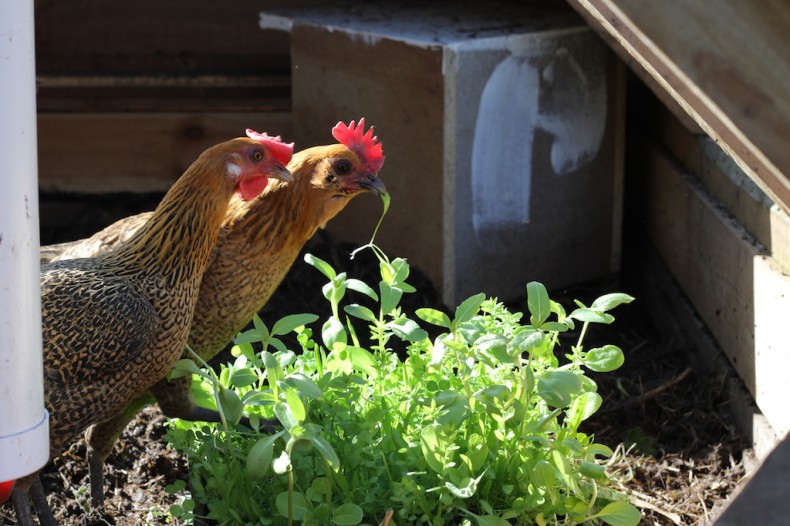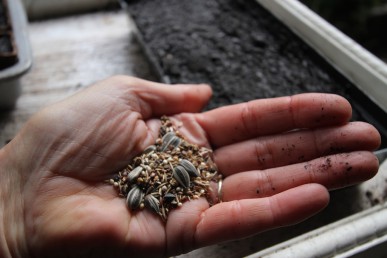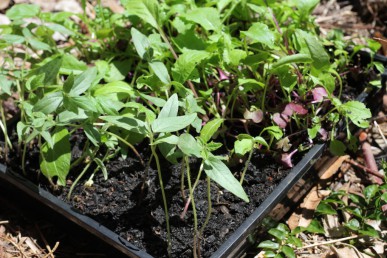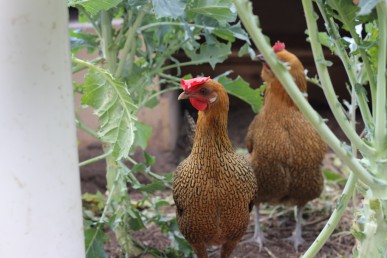By Penny Woodward
A variety of green feed is essential to chook welfare and happiness. This can be achieved in a number of different ways, ranging from allowing your chooks to free-range to supplying all their greens in the chook pen. My girls don’t free-range, their pen, though, does get moved every few weeks to a new position. I provide them with fresh green leaves every day, usually just dropped into the pen. Alternatively they can be hung in a bunch, or placed into a basket. Keeping them off the ground helps to keep the leaves clean and prevents contamination from chook poo. Plants that can be harvested from the average garden and fed to chooks are weeds like dandelions, milk thistle and cleavers; vegie leaves such as brassica, lettuce and silverbeet, and herbs including borage, comfrey, lemon balm, nasturtiums and chicory. Some of these can also be grown in pots, placed in the pen and then removed to re-grow. Comfrey is a particularly important green for chooks as it is high in protein, potassium and calcium, as well as several important amino acids. I try to make sure my hens have a little comfrey every day.
Another way to ensure that your chooks get all the greens they need, is to grow microgreens. With my system, towards the end of the chooks stay on each garden bed, the soil has been well dug over and the waste crops have been consumed. It is at this point that I like to give them some extra nutrition and fun with trays of microgreens. Seed for microgreens can be purchased or you can make your own mix. I often use appropriate seed that is now out of date and add it to the purchased mix. If you have a larger chook pen you could temporarily fence off a section, and plant the greens there, allow the chooks in to graze, and then exclude them again to let them re-grow. But I don’t have a lot of space so I grow mine in seed trays that are placed into the pen. Lizzie and Jane (Campene, English Game crosses) peck at the green tops and then scratch out the roots, eating the lot over a few days.
A selection of seeds for microgreens
Barrel medic, Medicago truncatula, a small legume native to the Mediterranean. Helps to maintain nitrogen levels in soil as well as providing nutritious greens.Buckwheat, Fagopyrum esculentum, grown mainly for it’s nutritious seed, this is also a useful green plant.
Cabbage/broccoli and Chinese vegetables (Brassica species). Young seedlings are particularly high in vitamin C and soluble fibre, as well as selenium and carotenoids.
Chicory, Cichorium intybus, volatile oils in the leaves help to control internal parasites. Some forms of chicory have been specifically bred as forage plants.
Clover, Trefolium species, especially red and white clover, a nutritious and easily grown forage crop.
Corn, Zea maize, immature plants are highly nutritious as well as containing a natural antibiotic.
Garlic chives, Allium tuberosum, grow easily from seed and have some of the same attributes as garlic, helping to control worms and other parasites.
Linseed, Linum usitatissimum, as well as being used for oil and fibre (flax), linseed is a useful green sprout for stock including poultry.
Lucerne, Medicago sativa, is a well-known common pasture plant that also provides nutritious greens for chooks.
Millet, another important fodder and food plant, the most common of which is pearl millet, Pennisetum glaucum
Nasturtium, Tropaeolum majus, is easy to grow and much enjoyed by chooks. The peppery leaves help to control worms.
Plantain, Plantago lanceolata, this common weed is high in protein and minerals, as well as being tough and easy to grow.
Radish, Raphanus sativus, also has spicy, peppery leaves and is one of the easiest vegetables to grow from seed, so does well in a microgreen mix.
Silverbeet, Beta vulgaris subsp. cicla, is a well-known vegetable that is also a useful chook food as it is hight in vitamins, minerals and protein.
Sunflower, Helianthus annus. The seeds are quickly devoured by chooks and the seedlings are also nutritious.




